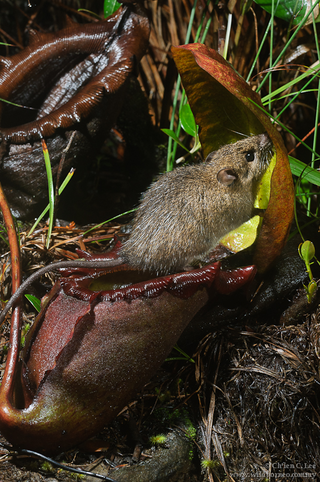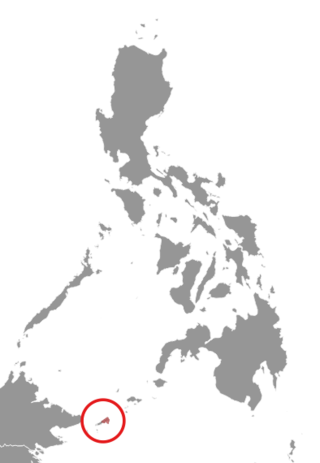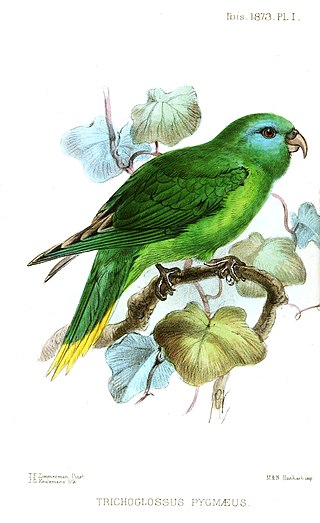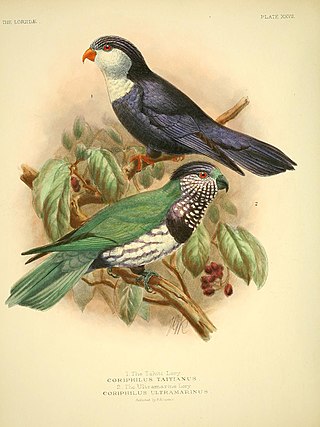
The black rat, also known as the roof rat, ship rat, or house rat, is a common long-tailed rodent of the stereotypical rat genus Rattus, in the subfamily Murinae. It likely originated in the Indian subcontinent, but is now found worldwide.

Rattus is a genus of muroid rodents, all typically called rats. However, the term rat can also be applied to rodent species outside of this genus.

The Oceanian realm is one of the World Wildlife Fund (WWF) biogeographic realms, and is unique in not including any continental land mass. It has the smallest land area of any of the WWF realms.

The Polynesian rat, Pacific rat or little rat, known to the Māori as kiore, is the third most widespread species of rat in the world behind the brown rat and black rat. The Polynesian rat originated in Southeast Asia, and like its relatives has become widespread, migrating to most of Polynesia, including New Zealand, Easter Island, and Hawaii. It shares high adaptability with other rat species extending to many environments, from grasslands to forests. It is also closely associated with humans, who provide easy access to food. It has become a major pest in most areas of its distribution.

The bulldog rat is an extinct species of rat formerly endemic to Christmas Island in the Indian Ocean. It was one of two rats endemic to Christmas Island, alongside Maclear's rat.
The nonsense rat, Nicobar Archipelago rat or Miller's Nicobar rat is endemic to the Nicobar Islands in India. It lives on Great Nicobar, Little Nicobar, and Trinket islands. On Car Nicobar Island, Rattus palmarum and Rattus anadamanensis live instead.

The Nicobar Islands rain forests is a tropical moist broadleaf forest ecoregion in the Nicobar Islands. The Nicobar Islands are in the Indian Ocean, lying north of Sumatra and south of the Andaman Islands. The islands are politically part of India, although physically closer to Southeast Asia. Millions of years of isolation from the mainland has given rise to a distinct flora and fauna, including many endemic species.

The summit rat is a species of rodent in the family Muridae. It is found only on Mount Kinabalu and Mount Tambuyukon, Malaysia, and has been recorded at altitudes of 2,040 to 2,477 m on Mt. Tambuyukon and 2,670 to 3,426 m on Mt. Kinabalu. They are most abundant in higher altitude dwarf forest and montane scrubland. The rat populations from these two peaks were connected in the Holocene. However, nowadays they are genetically isolated despite being 18 km apart. With current predictions of Global warming, the suitable habitat for Rattus baluensis is expected to shift around 500 m upwards. This will put the population in Mount Tambuyukon at risk. However, the population in Mount Kinabalu will likely survive in its upper slopes. Genetic analysis situate its origin in a local population of Rattus tiomanicus from northern Borneo at around 300-400 thousand years ago.
The Kerala rat or Ranjini’s field rat, is a species of rodent in the family Muridae found only in Kerala, India. In Kerala, it is known only from fragmented locations in Alappuzha, Thrissur, and Thiruvananthapuram. Its natural habitats are subtropical or tropical dry lowland grassland and swamps.
The Andaman rat is a species of rodent in the family Muridae. It is endemic to the Andaman Islands, where it has been recorded on Henry Lawrence Island, South Andaman, and Middle Andaman. It is a nocturnal species that lives in tropical evergreen forests from sea level to 200 m (660 ft) above sea level.

The Tawitawi forest rat or Tawitawi Island rat is a species of rodent in the family Muridae. It is found only in Tawi-Tawi, Philippines.

The Malayan field rat, Malaysian field rat or Malaysian wood rat, is a species of rodent in the family Muridae. It is nocturnal and mainly arboreal and is found in Malaysia, Thailand, Indonesia and the Philippines. It is a common species and the International Union for Conservation of Nature has assessed it as being of "least concern".

The Nicobar sparrowhawk is a species of bird of prey in the family Accipitridae. It is endemic to the Nicobar Islands of India. There are two subspecies, the nominate race which is found on Car Nicobar in the north of the archipelago, and A. b. obsoletus, from Katchal and Camorta in the central part of the Nicobars. A museum specimen originally attributed to this species from the island of Great Nicobar was later found to be a misidentified Besra.

The palm lorikeet is a species of parrot in the family Psittaculidae. It is found in the Santa Cruz Islands and Vanuatu. Its natural habitats are subtropical or tropical moist lowland forest, subtropical or tropical moist montane forest and plantations. It is threatened by habitat loss.

The ultramarine lorikeet is a species of parrot in the family Psittaculidae, endemic to the Marquesas Islands. Its natural habitats are subtropical or tropical moist lowland forest, subtropical or tropical moist montane forest and plantations. It is threatened mainly by introduction of the black rat and also by deforestation.

The Asian glossy starling is a species of starling in the family Sturnidae. It is found in Bangladesh, Brunei, India, Indonesia, Malaysia, Myanmar, the Philippines, Singapore, Taiwan (introduced), Cambodia and Thailand. Its natural habitats are subtropical or tropical moist lowland forest and subtropical or tropical mangrove forest. There is also a huge number of this species inhabiting towns and cities, where they take refuge in abandoned buildings and trees. They often move in large groups and are considered one of the noisiest species of birds. In the Philippines, it is known as kulansiyang, galansiyang, or kuling-dagat.

The freckle-breasted woodpecker is a species of bird in the family Picidae. It is found in Indonesia, Laos, Myanmar, Thailand, Cambodia, and Vietnam.

The Tuamotu tropical moist forests is a tropical and subtropical moist broadleaf forests ecoregion in the Tuamotu Archipelago of French Polynesia and the Pitcairn Islands.

Rattini is a very large, diverse tribe of muroid rodents in the subfamily Murinae. They are found throughout Asia and Australasia, with a few species ranging into Europe and northern Africa. The most well-known members of this group are the true rats, several species of which have been introduced worldwide.
















